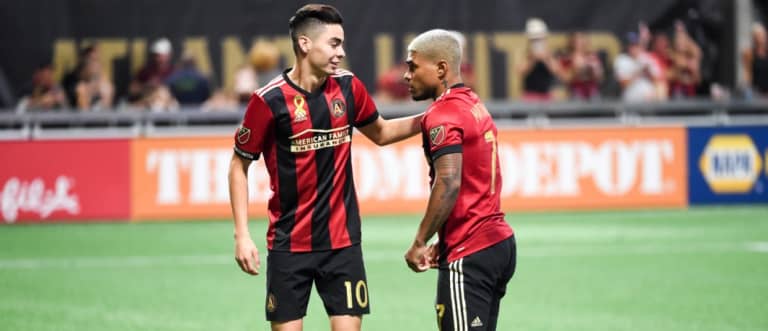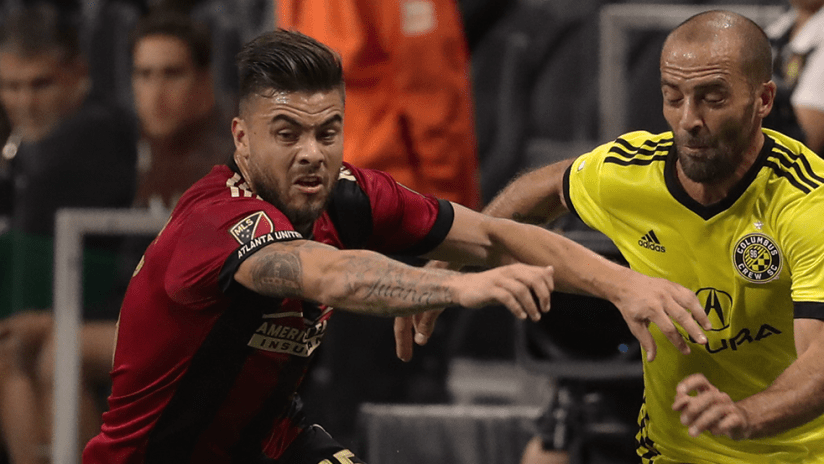LOS ANGELES – The increasing influx of exceedingly talented South American players, especially exceedingly talented young South American players, is redefining Major League Soccer, raising its standard of play and repositioning it within the game's global landscape.
MLS is quickly emerging as a prime market for rising talent, and that pipeline, along with glowing word-of-mouth recommendations, is luring players who 10 years ago would probably never have given the league a thought. This is the platform that vaults Miguel Almiron to Europe – maybe come summer – and teen phenom Ezequiel Barco will likely follow, after thrilling Atlanta United fans for a season or three.
There will be at least 67 South American players toiling in MLS this season – 16 newcomers, including Argentine midfielder Barco, have signed up so far after two dozen arrived last year – as the benefits of Targeted Allocation Money resonate through the rosters. It has long been a league of choice for players from Central America, which has handsomely benefited Costa Rica and Panama, and the top Mexicans in MLS these days are in their primes.
“Around the world, people are looking at this league growing up very fast,” Argentine playmaker Federico Higuain, a pivotal piece of Columbus Crew SC since 2012, proclaimed during Saturday's MLS media roundtable in Universal City, California. “Many, many players want to come here and enjoy the league.
“If somebody asks me about the league, I would say, 'Yes, come. You will enjoy it. You will love it.'”
The perception of MLS is rapidly changing. It's no longer a “retirement league,” but rather a difficult competition that – because of travel, weather extremes and utter parity among the clubs – tests players like few other places on the globe. It's not the EPL, the Bundesliga or La Liga, but it prepares players for the jump to Europe's big leagues.
“I see MLS as a very important league,” said Venezuelan striker Josef Martinez, who joined Atlanta United last year from Serie A side Torino. “If you perform well here, you have a chance to go to Europe, and, yes, you welcome that opportunity. ... I talk a lot to my teammates. I encourage them to play well, follow their dreams, try to do the best that you can have have the best consequences. I encourage them to leave their mark, to perform well, and if the opportunity to go to Europe arises, then you welcome that.”
That's how Almiron, 23, sees things. Atlanta's Paraguayan catalyst views MLS as a vital stepping stone to what awaits him, and thinks the next step could arrive “now” or “midseason.”

ATLUTD's Almiron and Martinez | USA Today Sports Images
“It's a [bridge to Europe]. Yes, it is,” he said. “The league is being watched so much around the world. ... My objective since I've been at Lanus is to go to Europe, [and] all players have to go through different stages in their career. ... I think a player always expects a transfer. I've worked for that.”
Almiron arrived from Lanus for about $8 million last year, and his selling price will almost surely be greater. Atlanta manager Tata Martino – something of a global billboard for MLS – brought his Argentina countryman Barco into the fold last week on a league-record transfer from Independiente. The Five Stripes expect a good return on the investment.
Players see this, are intrigued, and they ask friends in MLS, or friends of friends, about the league. And as more and better players come to MLS, others want to follow.
“They're always asking me about the league, the people in Peru,” said Orlando City SC defender/midfielder Yoshimar Yotun, one of MLS’ four Peruvians. “I tell them it's a very strong, league, high competition in a league that's growing a lot, and they know that if they have an interest, they can reach out to me, and I can let them know more specifically about how the league works.”
Martinez is an ambassador for Venezuelan talent. The contingent has more than doubled to seven players this year with the acquisitions of 20-year-old defender Jose Hernandez by Atlanta, 21-year-old midfielder Eduardo Sosa by Columbus, 21-year-old defender Alejandro Fuenmayor by Houston, and 27-year-old Swiss-born right back Rolf Feltscher by the LA Galaxy.
“I feel proud that I am able to contribute, and not only myself, but also [New York City FC's Manchester City loanee] Yangel Herrera,” Martinez said. “For us, it's very important for Venezuelan players to achieve their dreams to play internationally, and so it's great that they come here to MLS.”
The decision isn't a simple one, said Portland's Argentine midfielder Diego Valeri.
“[Prospective players] have some voices say go to a different league, but they can see that if they integrate different [assessments] to make a decision, MLS is the right place to come,” he said. “It's the right place for a lot of things: Competitive perspective, future perspective, life perspective. Time will be changing those voices, and you can see [that] now.”
South Americans have always played massive roles in MLS. The first player the league ever signed was Uruguayan-born US national team star Tab Ramos. Colombia's Carlos Valderrama was the first MVP – six South Americans have followed him, with Valeri claiming the honor last season – and D.C. United's early MLS Cup triumphs were built on Bolivians Marco Etcheverry and Jaime Moreno. Guillermo Barros Schelotto, Leonel Alvarez, Juan Pablo Angel and Javier Morales are MLS legends.

Giovani dos Santos at this month's MLS media roundtable
Nearly 400 South Americans have trod across MLS fields – and nearly another 400 from elsewhere in Latin America. And their countrymen have noticed. Argentine midfielder Ignacio Piatti was a fan of MLS before he joined the Montreal Impact four years ago.
“I like this league a lot,” he said. “I used to watch it when Guillermo Barros Schelotto was playing in Columbus. ... I don't regret coming here. I like it here. I like the life that I have in Canada.”
Piatti says domestic soccer in Argentina “is a beautiful thing, but one moment, if you play really well, you're Messi. And then if another game, you don't play so well, then they put a lot of pressure on you. They criticize you a lot. So I like it here.”
There is less pressure in MLS, owing mostly to distinct cultural differences, especially in sport, between the US and Canada and the rest of the world.
“A good thing [about] this league is nobody bothers you,” Higuain said. “The pressure is a little bit low. I'm not saying that in this league you don't have pressure. I'm saying in other countries, maybe the pressure is very crazy.”
That's a plus – MLS fans don't tend to attack their team's buses or confront players in the parking lot after poor performances – and so is the standard of living and virtual anonymity, as long as your name isn't David Beckham.
“If we stay here for a long time, we are content, because we are living well, there are good stadiums, good competition,” said Minnesota United's Costa Rican defender Francisco Calvo. “And if the press or players in other countries feel it's a step down, that's their problem.”
It is, sometimes, a problem.
“It's a strong league, but I think people think you come here to relax and take it easy,” said the Galaxy's Mexican midfielder Jonathan dos Santos. “But you have to work hard and be prepared. I've learned a lot, and I'm very happy to be here, because I know I can become better as a player [in MLS].”














